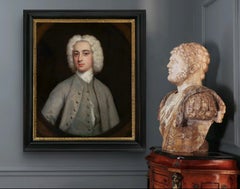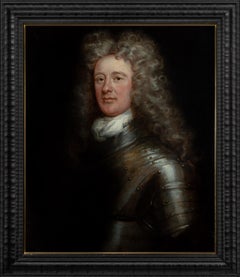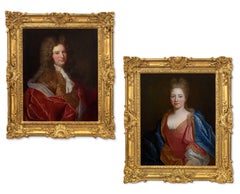Want more images or videos?
Request additional images or videos from the seller
1 of 9
Portrait of a Gentleman in Scarlet Robe Holding Flowers c.1675, Oil on canvascirca 1675
circa 1675
$10,959.96List Price
About the Item
- Attributed to:John Greenhill (1644 - 1676)
- Creation Year:circa 1675
- Dimensions:Height: 55.12 in (140 cm)Width: 44.1 in (112 cm)Depth: 2.37 in (6 cm)
- Medium:
- Movement & Style:
- Period:
- Condition:This painting has passed a strict quality and condition assessment by a professional conservator prior to going on sale. It can be hung and enjoyed immediately.
- Gallery Location:London, GB
- Reference Number:1stDibs: LU1199114075192
About the Seller
5.0
Vetted Professional Seller
Every seller passes strict standards for authenticity and reliability
Established in 1998
1stDibs seller since 2019
45 sales on 1stDibs
Typical response time: 2 hours
Authenticity Guarantee
In the unlikely event there’s an issue with an item’s authenticity, contact us within 1 year for a full refund. DetailsMoney-Back Guarantee
If your item is not as described, is damaged in transit, or does not arrive, contact us within 7 days for a full refund. Details24-Hour Cancellation
You have a 24-hour grace period in which to reconsider your purchase, with no questions asked.Vetted Professional Sellers
Our world-class sellers must adhere to strict standards for service and quality, maintaining the integrity of our listings.Price-Match Guarantee
If you find that a seller listed the same item for a lower price elsewhere, we’ll match it.Trusted Global Delivery
Our best-in-class carrier network provides specialized shipping options worldwide, including custom delivery.You May Also Like
Oil Portrait of a Victorian Lady, c. 1850
Located in Chicago, IL
Painted in the 19th century, this exquisite miniature portrait wonderfully exemplifies realism in traditional oil painting. The small artwork is painted in the conventional portraiture style of the Old Masters, and achieves soft realism with fine brushwork and a subdued, neutral palette. The half length portrait depicts a fine Victorian woman dressed in all black with a delicate lace collar and bonnet. She wears a ruby broach...
Category
Mid-19th Century Old Masters More Art
Materials
Oil
Robert K. White "Kelly Slater" Oil on Canvas, Realist Portrait of Surf Legend
Located in Miami, FL
ROBERT KENNETH WHITE – "KELLY SLATER"
Oil on Canvas ⚜ Hand Signed Lower Right ⚜ Frameless Display
A PORTRAIT OF FOCUS, LEGACY, AND DEPTH
Rendered with near-photographic precision, ...
Category
2010s Realist Portrait Paintings
Materials
Canvas, Oil
$6,500 Sale Price
35% Off
H 40 in W 28 in D 0.875 in
Robert K. White "Girl with Red Hair" Signed Oil, Contemporary Realist Portrait
Located in Miami, FL
ROBERT KENNETH WHITE – "GIRL WITH RED HAIR"
Oil on Canvas ⚜ Hand Signed Lower Right ⚜ Frameless Display
A PORTRAIT STUDY OF STRENGTH AND INTROSPECTION
In this emotionally charged p...
Category
2010s Realist Portrait Paintings
Materials
Canvas, Oil
$3,900 Sale Price
35% Off
H 24 in W 20.125 in D 0.875 in
"The Shining 2" - Colorful Female Figurative Swimmer Portrait Painting
Located in West Hollywood, CA
This 36 inch square original oil painting on canvas is wired and ready to hang. The detail in this artwork is astounding. The crimson red tones make the female swimmers portrait real...
Category
2010s Contemporary Portrait Paintings
Materials
Canvas, Oil
$4,000
H 36 in W 36 in D 1.5 in
"Army of Snorkelers" - Mirrored Female Swimmer Portrait Painting
Located in West Hollywood, CA
This large horizontal 37 inch high and 76 inch wide original oil painting on canvas is wired and ready to hang. The detail in this artwork is astounding. The crimson red tones make t...
Category
2010s Contemporary Portrait Paintings
Materials
Canvas, Oil
$6,000
H 37 in W 76 in D 1.5 in
European Portrait of a Priest
Located in Milford, NH
A fine European portrait of a priest, oil on canvas, probably dating to the 17th or 18th century, unsigned, with original stretcher, minor surface losses and damage, craquelure, edge...
Category
17th Century Portrait Paintings
Materials
Canvas, Oil
"Christian (Brother)" Haitian Boy Portrait in Yellow Shirt
Located in Philadelphia, PA
This piece titled "Christian (Brother)" is an original artwork by Alain Jean-Baptiste and measures 60"h x 48"w. This oil work on canvas reflects on the buildup and aftermath Jean-B...
Category
21st Century and Contemporary Contemporary Portrait Paintings
Materials
Oil, Canvas
$5,000
H 60 in W 48 in
Brown Eyed Girl - 4"x4", Original Painting On Canvas, Small, Doll-Like Portrait
By Andrea Stajan-Ferkul
Located in Mississauga, Ontario
With attention to detail, this delightfully delicate painting on canvas places focus on the brown eyes which have a way of drawing you in. The portrait blends acrylic paint and colou...
Category
2010s Contemporary Portrait Paintings
Materials
Canvas, Acrylic, Pencil, Color Pencil
Blue Eyed Girl - 4"x4", Original Painting On Canvas, Small Portrait, Blonde
By Andrea Stajan-Ferkul
Located in Mississauga, Ontario
With attention to detail, this delightfully delicate painting on canvas places focus on the blue eyes which have a way of drawing you in. The portrait blends acrylic paint and colour...
Category
2010s Contemporary Portrait Paintings
Materials
Canvas, Acrylic, Pencil, Color Pencil
$650
H 4 in W 4 in D 1.5 in
Brown Eyed Girl + Blue Eyed Girl -2 Original Paintings On Canvas
By Andrea Stajan-Ferkul
Located in Mississauga, Ontario
With attention to detail, this delightful pair of paintings on canvas highlight the eyes, making them a focal point of each piece. The blending of acrylic paint, pencil and coloured ...
Category
2010s Contemporary Portrait Paintings
Materials
Canvas, Acrylic, Pencil, Color Pencil
$1,200
H 4 in W 4 in D 1.5 in
More From This Seller
View AllPortrait of a Gentleman in Grey Coat & White Cravat, Oil on canvas Painting
Located in London, GB
This exquisite work, presented by Titan Fine Art, is by the notable artist Hans Hysing, who was a noteworthy painter in England; it is significant in its q...
Category
18th Century Old Masters Portrait Paintings
Materials
Canvas, Oil
Portrait of a Gentleman, David Erskine, 13th Laird of Dun, Wearing Armour c.1700
Located in London, GB
The gentleman in this exquisite oil on canvas portrait, presented by Titan Fine Art, is shown with the grandiloquence characteristic of the English School of painting. He is portray...
Category
17th Century Old Masters Portrait Paintings
Materials
Oil, Canvas
Portrait of Gentleman Blue & Cloak, Portrait of Lady, Fine Carved Gilded frames
Located in London, GB
Portrait of a Gentleman with Blue Cloak and Portrait of a Lady in Russet Dress c.1697
Thomas Murray (1663-1735)
These fascinating portraits are exquisite examples of portraiture in ...
Category
17th Century Old Masters Portrait Paintings
Materials
Oil, Canvas
Portrait of a Lady and Portrait of Gentleman, Velvet & Silk Attire c.1700 French
By Nicolas de Largillière
Located in London, GB
These lavish portraits, presented by Titan Fine Art, illustrate the elegant and exuberant type of portrait that the French court and the bourgeoisie favoured at the end of the 17th c...
Category
17th Century Old Masters Portrait Paintings
Materials
Canvas, Oil
Portrait of a Lady in Green Dress & Pearl Jewellery c.1660 Painting John Wright
By John Michael Wright
Located in London, GB
In this exquisite work, painted around the time of the Great Fire of London in 1666, a beautiful young woman is wearing a green dress over a white chemise and a russet-coloured scarf...
Category
17th Century Old Masters Portrait Paintings
Materials
Canvas, Oil
Portrait Gentleman Armour, Blue Cloak, Diamond Brooch c.1700 French Carved Frame
By Joseph Vivien
Located in London, GB
Portrait of a Gentleman in Armour and Azure Cloak with Diamond Brooch c.1700
Attributed to Joseph Vivienne (1657-1735)
The sitter in this superb portrait, offered by Titan Fine Art...
Category
17th Century Old Masters Portrait Paintings
Materials
Oil, Cotton Canvas
Recently Viewed
View AllMore Ways To Browse
Oxford Library
George Vertue
Bodleian Library
Antique Gutters
Titan Fine Art
African American Portrait Painting
Coronation Painting
Danse Macabre
Military Portrait Paintings
Native American Portraits
Painting Of African Woman
Woman Portrait Black Dress
1944 Portraits
Middle Temple
Miniature Portrait Of A Boy
Parisian Vintage Dresses
Steve Kaufman Marilyn
18th Century British Portrait



